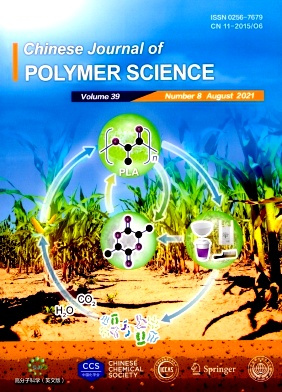Chinese Journal of Polymer Science
CSCDCSSCI《Chinese Journal of Polyer Science》創刊于1983年,為月刊,由中國化學會;中國科學院化學研究所主辦。
《Chinese Journal of Polyer Science》主要出版發行分子層面的有面、無機、分析、物理化學、生物、高分子等領域高水平的研究綜述、論文、快報和簡報。
<dl id="q0oyq"></dl>

《Chinese Journal of Polyer Science》創刊于1983年,為月刊,由中國化學會;中國科學院化學研究所主辦。
《Chinese Journal of Polyer Science》主要出版發行分子層面的有面、無機、分析、物理化學、生物、高分子等領域高水平的研究綜述、論文、快報和簡報。
Feature;Articles;Papers;Notes;Rapid;Communications
Chinese Journal of Polymer Science雜志投稿須知:Instructions to AuthorsSubmissionPapers appearing in the Journal comprise Regular Articles, Notes, Rapid Communications, which should contain original information, theoretical or experimental, on any topics in the field of polymer science and polymer material science. Feature Articles are also welcome. Papers already published or scheduled to be published elsewhere will not be accepted.Notes and Rapid Communications are limited to less than four pages of the Journal. Notes are concerned with subjects of limited scope, which require no further information in a future publication. Rapid Communications deal with significant findings worthy of urgent publication. Feature Articles are limited to review of the author's own results in a systematic research, which have been published recently, in part or in whole.For papers submitted for publication as Rapid Communications, a brief introduction outlining the significance of the work and the rationale for urgent publication must be submitted together with the manuscript.Manuscripts should be submitted via web-based online submission systemManuscriptsManuscripts should be written in English, double-spaced and single-sided on A4 sheets with margins of 3 cm all round, and should be numbered beginning with the title page. The first page of an article should contain only
1、 the title of the paper, 。
2、 the name(s) and address(es) of the author(s), 。
3、 an abstract of 50-250 words, 。
4、 3-5 keywords and 。
5、 an abbreviated title not exceeding 45 characters (including spaces) for the running head.Heading and Subheadings for different sections of the paper should be clearly indicated.Units of measurement, abbreviations and symbols should follow the International System of Units (SI). Equations and formulae should be typed clearly. Equations should be numbered consecutively with Arabic numerals in parentheses on the right-hand side of the page. Any special symbols should be identified in the margin.Tables should be typed on separate sheets together with a suitable caption at the top of each table. All the tables should be numbered consecutively in Arabic numerals.Figures should be submitted on separate sheets and numbered consecutively in Arabic numerals. All figure captions should be summarized on a separate sheet after the text. For best results, figures should be submitted at the actual size at which they should appear in the journal and fit a half column width(Max. 8.0 cm). A full column width (Max. 17 cm) will be considered only when absolutely necessary to the clarity of the figure. For figures, the minimum font size should be 8 pt and the minimum line width should be 0.4 pt. TIFF, EPS or JPG files are the preferred format. Suggested packages for line graphics are Origin (preferred, please use line width 2 and symbol size 12), Adobe Illustrator (version 3.0 or above), Freehand and Corel Draw. Files of scanned line graphics can be accepted preferably at a resolution of 1000dpi (Min. 600dpi). Black and white photos, micrographs etc should not be saved as color.References should be cited in the text with Arabic numerals within square brackets in order of appearance, and listed at the end of the paper in numerical order. The following style should be followed for the reference list:Journal:Reference number, surname, initial(s), journal, year of publication, volume number: page number1 Mochel, K.D., J. Polym. Sci., A-1, 1972, 10: 10092 Wang, H.L., Chen, J.M., Huang, Y. and Shen, J.R., Chinese J. Polym. Sci., 1997, 15(10): 573 Einaga, Y. and Fujita, H., Polymer, in pressBooks:Reference number, surname, initial(s), "title", edition, publisher, place of publication, year, page number4 Zhou, Q.F. and Wang, X.J., "Liquid crystalline polymers" (in Chinese), Science Press, Beijing, 1994, p.885 Schmidt, H., in “Hanbook of environmental chemistry, Vol. 2E”, ed. by Hutzinger, O., Springer, Berlin Heidelberg New York, 2003, p.111Patents:Reference number, inventor's surname, initial(s), or patentee (firm), year, patent number6 Furukawa, J., Kobayashi, E. and Takahire, K., 1974, U.S.Pat., 3,817,968Theses (PhD)Reference number, surname, initial(s), “title”, thesis, university, (place of university), year7 Trent, J.W., “Experimental acute renal failure”, Thesis, University of California, 1975Graphical AbstractAll manuscripts must be accompanied by a graphical abstract which will be published in the Journal’s Table of Contents. The graphical abstract consists of a brief summary and a graphic highlighting the key findings of the work. Such summaries are limited to 50 words in length and should not be confused with the abstract. The graphic could be a key figure or scheme of the manuscript or a graphic specially prepared for Table of Contents. The graphic could be in the form of a structure, reaction/mechanism scheme, graphical data, photograph etc., but tables or spectra are not recommended. Color graphic is encouraged. The Graphical Abstract should be incorporated on the last page of the manuscript. The authors are asked to supply the materials in the following format:Graphical Abstract“Title of the manuscript”AuthorsBrief summaryGraphic
影響因子:指該期刊近兩年文獻的平均被引用率,即該期刊前兩年論文在評價當年每篇論文被引用的平均次數
被引半衰期:衡量期刊老化速度快慢的一種指標,指某一期刊論文在某年被引用的全部次數中,較新的一半被引論文刊載的時間跨度
他引率:期刊被他刊引用的次數占該刊總被引次數的比例用以測度某期刊學術交流的廣度、專業面的寬窄以及學科的交叉程度
引用半衰期:指某種期刊在某年中所引用的全部參考文獻中較新的一半是在最近多少年時段內刊載的
平均引文數:在給定的時間內,期刊篇均參考文獻量,用以測度期刊的平均引文水平,考察期刊吸收信息的能力以及科學交流程度的高低
書已經收到了,還沒來得及看。這本書是孩子的老師推薦的,肯定是本好書,發貨速度很快,快遞也很好,這個網站客服的態度也很好。很滿意的一次購物!
書是很好啊,不得不說非常好。內容不錯,非常喜歡,當時有活動,價格也很實惠,還不錯的投稿網,有信譽。發貨速度很快,每次都及時的收到了,我會繼續支持下去的,贊贊贊。
投稿一個月被拒,有點非專業口的感覺,專家不一定很專!給的意見文中很清楚,但是還要做為退稿的理由,編輯態度應該點贊!
前后共歷時3個多月,兩個審稿人建議直接發表,編輯覺得太順利了,就又邀請了一個編委作為第三個審稿人,耽誤了一個月的時間,編委提了點概念用詞的建議,修改后發表,最后又和主編討論了幾次,最后錄用。Chinese Journal of Polymer Science雜志的效率感覺沒有之前快了,去投的一篇,一個月就被錄用了,期間還修改了一次。
審稿還算比較快,如果稿件質量有保證的話,一般一個月內有回應。
雜志無論是裝幀還是內容都是的優秀!非常值得一看,更值得細細品味!建議大家購買這本書,讀來受益匪淺。封面設計經典,紙張手感好,閱讀舒適。時不時拿出來讀一讀。
這是一本比較有深度有廣度的期刊,一直都有在閱讀。今的雜志都是在投稿網定的,而且沒有發生漏寄的情況,服務態度也蠻不錯的。在他們的網站上,還可以查詢到詳細的訂單情況,感覺蠻專業的。而且雜志都有打折,很值得推薦!
審稿速度很快,兩周外審就結束了,我運氣不錯,小修了兩三天返回去,隔天就錄用了,審稿人的意見不多,但是都挺有價值。值得一提的是,編輯的排版很仔細,太負責了!這樣的編輯團隊,值得夸贊。
很不錯的雜志,注重文章的創新性及論文語言的流暢性,偏應用。Chinese Journal of Polymer Science雜志格式要求嚴格,有外審意見了就老老實實的按照雜志格式以及專家意見修改就好,對自己的成果要有信心,用心去做,不太難中。
很幸運通過初審,從投稿到初審通過差不多半個月,效率還是蠻高的,從投稿到錄用,差不多用了個半月的時間。在這過程中編輯老師很有耐心,一直跟作者保持著良好溝通,贊一個。
| Q:論文發表的時候可以一稿多投嗎? |
| A:一稿多投的行為是典型的學術不端的行為,是國內外學術界都明令禁止的行為,原因主要在于涉及到文章版權歸屬的問題,如果作者的文章已經被某個雜志社錄用,或者同時被兩家雜志社錄用,就會涉及到版權糾紛,作為雜志社都會保護本社的合法權益,到這時作者就會比較麻煩,吃官司都是小事兒了,被打入黑名單降級降職影響可就太大了。 |
| Q:職稱論文發表對時間有限制嗎? |
| A:職稱論文發表并沒有明確規定截止時間,需要作者結合自己所在地區的具體規定自己安排發表時間,一般職稱評審,各地區都會明確規定申報材料的最后期限和截止日期,我們結合這個日期來考慮何時發表文章就可以,大部分地區職稱評審都集中在每年的8-10月之間,有的地區要求7月中旬開始交材料,最晚8月底之前,有的則是要求8月中旬交,還有部分地區要求截止時間為申報時間上年的12月31日,所以,各個地區的具體要求并不同,申報者需要在提交材料前確保自己的文章已經見刊并且被相應的數據庫檢索即可。 |
| Q:網上發表論文如何防騙?可靠網站與可疑網站如何區分? |
| A:由于發表論文的需求遠遠多于雜志版面的供應,再加上眾所周知的審稿難!審稿慢!選擇論文發表網站發表表論文確實能解決以上問題。賣方市場的出現加之發表論文的剛性需求,就導致出現先付款后發表的現狀。論文發表網站正規與否是通過網站從始至終所提供服務體現出來的,任何交易只要存在時間差都會有風險,但這個風險是可以通過您的智慧來避免的。因為不是所有論文網站都是騙子,你要做的就是過濾掉沒保障的網站,選擇可靠的論文發表網站! |
| Q:一般期刊需要提前多久準備? |
| A:省級、國家級期刊建議至少提前6個月準備。一般來講,雜志社為了確保每期雜志正常出刊,都會提前將當期之后1-3個月的稿件提前安排好,而一些創刊較早,認可度更高的熱門期刊,來稿量較大,發表周期可能就會更久。提前準備,意味著雜志的可選擇性更多。 |
| Q:核心期刊需要提前多久準備? |
| A:核心期刊建議至少提前12個月準備,核心期刊正常的審稿周期為1-3個月,且審核嚴格,退稿、返修幾率更大,這意味著在流程上耗費的時間更久,且核心期刊版面有限,投稿競爭更加激烈,即使被錄用,排刊也比普通期刊晚很多,因此需要更早準備。 |